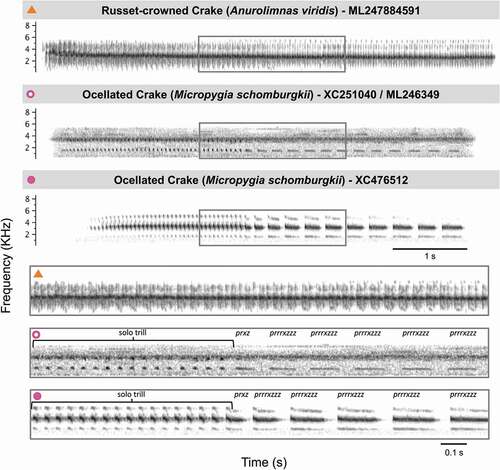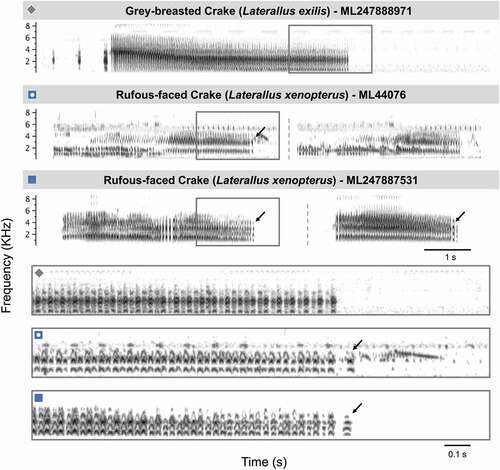Figures & data
Figure 1. Spectrograms comparing vocalizations of Russet-crowned Crake, Anurolimnas viridis, and Ocellated Crake, Micropygia schomburgkii. The top three spectrograms show trills of Anurolimnas viridis and Micropygia schomburgkii. The three bottom spectrograms in solid-line boxes belong to zoomed-in insets of the corresponding top spectrograms. The pink circle with white dot corresponds to the first country record of Micropygia schomburgkii for Ecuador (originally identified by the recordist as Russet-crowned Crake, Anurolimnas viridis). Note duet trill of Anurolimnas viridis, in contrast to solo trills of Micropygia schomburgkii followed by diagnostic prrrxzzz “crying” notes. See Appendix 1 for recordings supporting information

Figure 2. Spectrograms comparing vocalizations of Grey-breasted Crake, Laterallus exilis, and Rufous-faced Crake, Laterallus xenopterus. The top three spectrograms show duet trills of Laterallus exilis and Laterallus xenopterus. The bottom three spectrograms with solid lines belong to zoomed-in insets of the corresponding top spectrograms. The blue square with white dot corresponds to the first country record of Laterallus xenopterus for Peru (originally identified by the recordist as Grey-breasted Crake, Laterallus exilis). Note longer note duration, more tonal notes, and diagnostic isolated final note (diagonal arrows) of Laterallus xenopterus in comparison to harsh notes that rapidly descend in pitch in Laterallus exilis. See Appendix A for recordings supporting information

Figure 3. Map showing localities of Rufous-faced Crake, Laterallus xenopterus, and Ocellated Crake, Micropygia schomburgkii, in central west South America (data from [Citation6]). New country records of Micropygia schomburgkii for Ecuador, and Laterallus xenopterus for Peru, are shown in symbols with a white dot
![Figure 3. Map showing localities of Rufous-faced Crake, Laterallus xenopterus, and Ocellated Crake, Micropygia schomburgkii, in central west South America (data from [Citation6]). New country records of Micropygia schomburgkii for Ecuador, and Laterallus xenopterus for Peru, are shown in symbols with a white dot](/cms/asset/cc40fcbc-61b9-4c39-9e22-2e7603e37258/tneo_a_1878983_f0003_oc.jpg)
